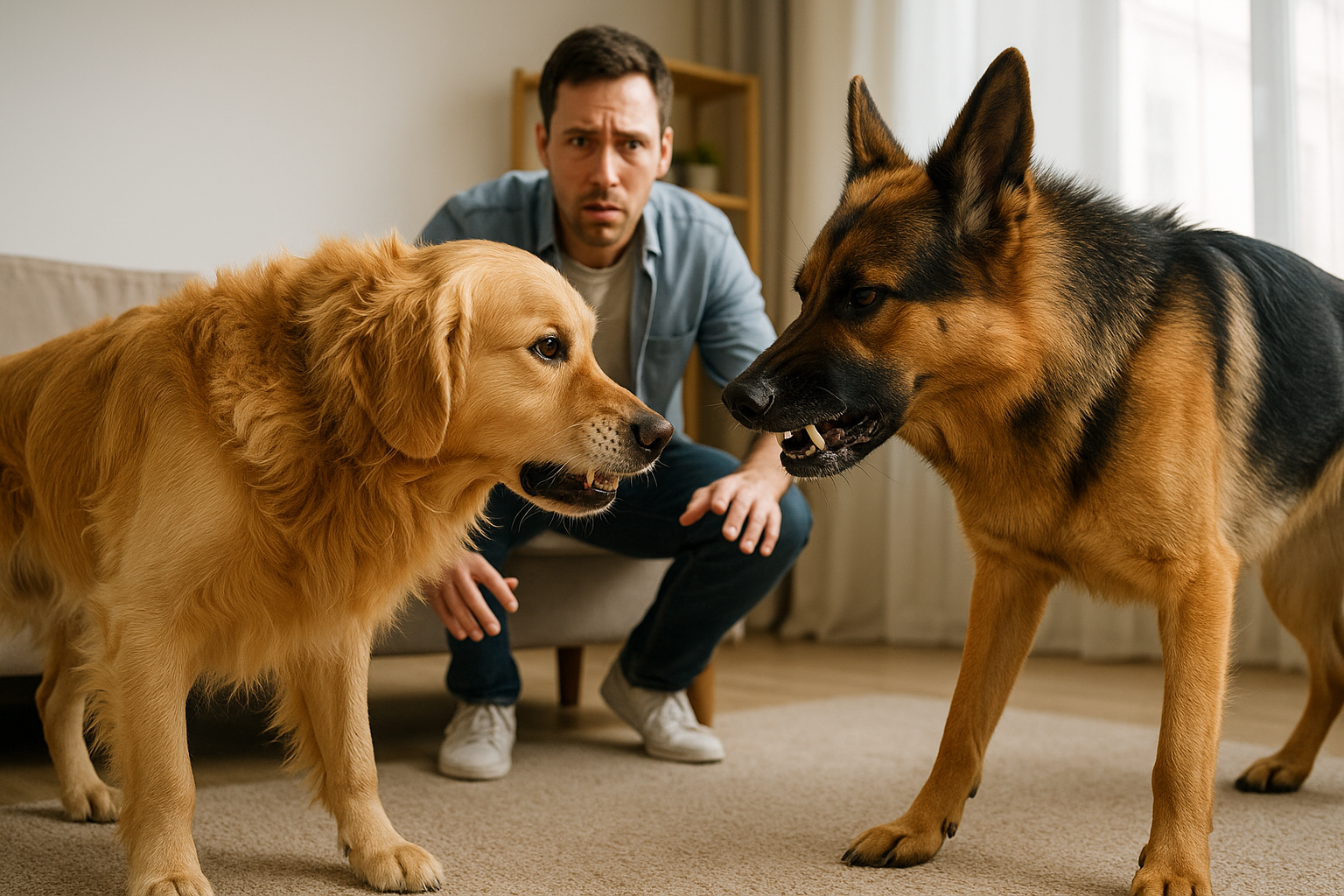It's not just the dogs that get scared and hurt during fights, the owners of the dogs can get hurt too. So, it becomes important that you keep calm and move quickly. The best way to stop a dog fight is to separate the dogs right away. Someone who works with dogs or the animal control officer may be able to help you if the dogs are being too mean.
Don't worry if you don't know how to break up a dog fight. Today, we'll talk about why dogs fight, how to spot warning signs, how to break up fights, and how to stop them from happening again. Okay, let's begin!
Introduction
So, now comes the question: how to break up a dog fight? Dog fights often occur due to specific situations or behaviors. Knowing the reasons behind dog fights and how to handle them effectively will help both you and your furry companions in the long term.
One practical way to lower the risk is using a dog playpen at home or while camping. A playpen creates safe boundaries that help prevent fights before they even start.
Understanding Why Dog Fights Happen
Dogs mostly talk to each other using their bodies and actions. Sometimes, they misunderstand each other, get stressed, or feel like they need to protect their space. This often leads to ugly fights. Knowing how to stop dogs from fighting by staying calm and using the right methods becomes very important to avoid injuries.
Common Causes of Dog Fights
Resource Guarding
Dogs often fight to protect resources such as food, toys, or even their favorite spot on the couch. Using a playpen can separate dogs during mealtime and reduce this risk.
Overstimulation or Play Escalation
Rough play can occasionally become uncontrollable and eventually result in aggression.
Fear or Anxiety Trigger
Fearful dogs may lash out when they feel cornered or threatened.
Dominance or Territorial Aggression
Some dogs have a strong instinct to establish dominance or protect their territory.
Encounters with Unfamiliar Dogs
Dogs meeting for the first time may feel unsure or defensive, particularly in unfamiliar environments.
Signs a Dog Fight Is About to Start
Body Language Cues to Watch For
-
Raised Hackles: A sign of heightened arousal.
-
Intense Staring: Indicates a challenge or perceived threat.
-
Growling or Snarling: Verbal warnings of discomfort or aggression.
Understanding the Escalation Stages
Instead of learning how to break up a dog fight by yourself, try identifying signs of escalation. Aggression often builds in stages. Recognizing early signs can help you intervene before a fight begins.
How Can You Prevent a Fight Before It Happens?
-
Redirect your dog’s attention with treats or toys.
-
Remove potential triggers, such as food or toys.
-
Separate dogs showing signs of discomfort.
-
Set up a playpen when multiple dogs are around. This gives each dog its own safe space and lowers the chance of conflicts.
Techniques for Safely Breaking Up a Dog Fight
What Not to Do
-
Avoid Grabbing Collars or Intervening with Hands: Dogs may redirect their aggression toward you.
-
Risks of Yelling or Screaming: Loud noises can escalate the fight further, so avoid yelling.
Effective Methods for Breaking Up a Fight

The best way to stop a dog fight is to separate the dogs right away. According to the AKC, these are some of the safest methods to separate fighting dogs.
-
Using the “Wheelbarrow” Technique: Lift the hind legs of each dog and pull them apart.
-
Interrupting with a Loud Noise: You can use a whistle or clap your hands to startle the dogs.
-
Spraying Water or Using Citronella Spray: These harmless tools can distract and deter fighting.
-
Throwing a Blanket or Object Over the Dogs: This can disorient the dogs and give you a chance to separate them.
-
Calling for Help: You can enlist another person to help if multiple dogs are involved.
How to Break Up a Dog Fight Safely?
Protecting Yourself from Bites or Injuries
Always prioritize your safety by using tools like leashes, barriers, or protective gloves.
Using Tools Like Leashes or Barriers
Leashes and portable barriers can help you gain control without physical contact.
A playpen also works as a safe barrier, letting dogs calm down in separate spaces after a fight without risking another confrontation.
Wearing Protective Clothing for Risky Situations
Thick clothing or gloves can reduce the risk of injury if physical intervention is necessary.
After the Fight: Next Steps
Separating and Calming the Dogs
Separate the dogs and allow them to calm down in different areas. Avoid reintroducing them immediately.
Placing each dog inside a playpen can help them cool off safely and avoid direct re-engagement.
Checking for Injuries
Examine common bite wound areas, including the neck, legs, and face. Seek veterinary care if wounds are severe or if you notice signs of infection.
Monitoring for Behavioral Changes Post-Fight
You can look for signs of stress, fear, or aggression in dogs and deal with them quickly. Knowing how to safely break up a dog fight and getting professional help if needed can help manage these situations.
Preventing Future Fights

PetMD provides practical guidance on how to manage aggression triggers in daily life.
Training and Socialization Techniques
-
Teach basic obedience commands such as “sit,” “stay,” and “leave it.”
-
Gradually introduce your dog to new dogs and environments.
Identifying Triggers and Managing Environments
-
Recognize what causes your dog stress and avoid these triggers.
-
Manage high-stress situations by keeping your dog on a leash or in a secure space.
Investing in Professional Behavioral Training
You may need a professional, especially if you’re dealing with breeds like pit bulls, even if you know how to break up a dog fight. A professional trainer can help address underlying issues and prevent future conflicts.
At home, consistent use of a playpen can also serve as a preventive tool, limiting exposure to triggers and keeping your pets safe.
Special Situations
Breaking Up Fights Between Large vs Small Dogs
Focus on protecting the smaller dog, as they are at greater risk of injury.
What to Do When Multiple Dogs Are Involved
In this situation, you may need extra help to separate the dogs safely. You can use a thick cloth to cover the dogs, which helps calm them and prevent escalation. Wearing thick clothes protects against bites and scratches, making it less likely that you will get hurt while separating. Making sure everyone is safe lets you focus on handling the situation well and cooling down the dogs.
Using multiple playpens can also keep dogs separated and secure after such incidents, helping prevent chaos.
How to Handle Fights in Public Spaces
Knowing how to break up a dog fight using tools like leashes, sprays, or barriers can help you step in quickly and safely.
Understanding Dog Behavior Post-Fight

Why Some Dogs May Be Aggressive After a Fight
Dogs may remain on high alert or show lingering aggression due to stress or fear. This is also a big reason why you should know how to break up a pit bull fight.
Helping Dogs Rebuild Trust
-
Provide consistent training and positive reinforcement.
-
Avoid high-stress interactions until both dogs are comfortable again.
Long-Term Management Strategies for Aggressive Dogs
-
Use desensitization and counter-conditioning techniques.
-
Consult a veterinarian or behaviorist for persistent issues.
Conclusion
You must possess agility, maintain composure, and understand how to break up a dog fight. Preventative steps, like training and proper socialization, are very important for lowering the risk of fights. Always put your safety first, and if someone is being aggressive, talk to an expert.
Adding a dog playpen to your home or travel setup is an easy, practical way to prevent conflicts and keep dogs calm in their own space. It’s not just about breaking up fights, but also about creating an environment where fights don’t start in the first place.
FAQs
What is the safest way to break up a dog fight?
Using tools like leashes or barriers is the safest way to intervene.
Why should you avoid grabbing a dog’s collar during a fight?
Dogs may redirect their aggression and accidentally bite you.
How do I know if my dog needs medical attention after a fight?
Seek veterinary care for deep wounds, punctures, or signs of infection.
Can two dogs get along again after a fight?
Yes, with proper reintroduction and management, dogs can rebuild trust.
How can I prevent my dog from getting into fights in the future?
Focus on training, socialization, and managing stressful situations effectively.
What tools can I carry to stop a dog fight in public?
Carry a leash, citronella spray, or a portable barrier for emergencies.
Should I punish my dog after a fight?
No, punishment can escalate aggression or fear. Focus on training instead.
When should I consult a professional trainer for help with aggression?
If fights occur frequently or your dog shows persistent aggression, seek professional help.
How can I protect myself from being bitten during a fight?
Use protective tools like gloves or barriers to avoid direct contact with the dogs.


Share:
The Ultimate Guide to How to Introduce Newborn Puppies to Water
The Safest Way to Contain Your Puppy: Choosing Between Crates, Gates, Playpens